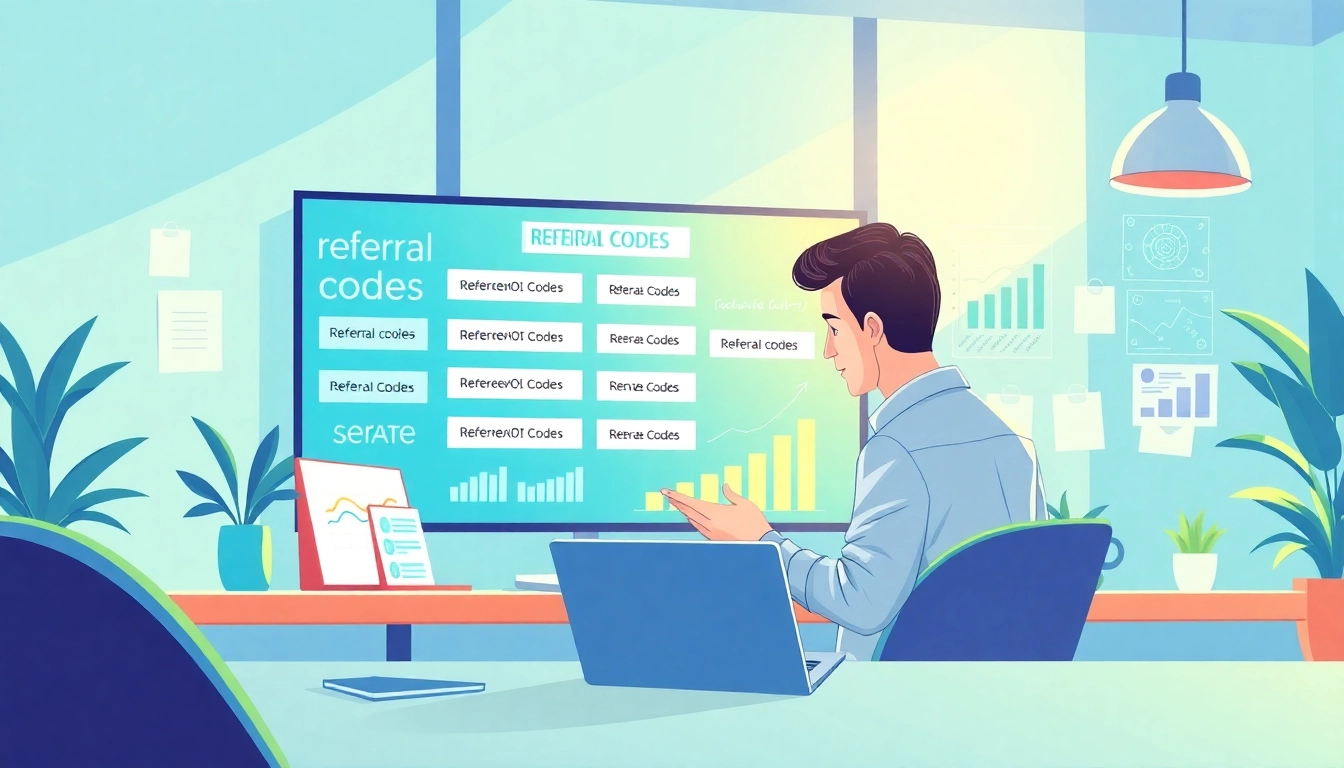Understanding Referral Codes
What are Referral Codes?
Referral codes are a unique set of alphanumeric sequences or strings assigned to existing customers to share with potential new customers. These codes serve as a crucial part of referral marketing strategies, enabling businesses to track and reward referrals effectively. When a potential customer uses a referral code during a transaction or sign-up, the system recognizes the source of the referral, ensuring the referring customer receives any promised rewards or incentives.
The Importance of Referral Codes
In today’s competitive market, effective customer acquisition strategies are vital for growing businesses. Referral codes offer a considerably low-cost method to gain new customers, leveraging existing customers’ satisfaction to drive new leads. Utilizing referral codes not only enhances customer engagement but also builds trust, as potential customers are more likely to respond positively to recommendations from friends or family rather than traditional advertising. Research shows that customers gained through referral programs have a higher retention rate and a greater lifetime value than those acquired through other means.
How Referral Codes Work
Referral codes function through a straightforward mechanism. A customer (the ‘referrer’) shares their unique code with a friend or acquaintance seeking a product or service. The new customer (the ‘referee’) enters this code during their purchase or registration. As a result, both parties often receive rewards, creating a win-win situation that incentivizes both sharing and purchasing. The mechanics generally involve:
- Creation of a unique code for the referrer.
- Sharing the code through various channels such as social media, email, or direct messaging.
- Tracking the usage of the code by the business’s referral program platform.
- Issuing rewards based on successful referrals, often in the form of discounts, cash bonuses, or credits.
Creating Effective Referral Codes
Best Practices for Crafting Referral Codes
To maximize the effectiveness of referral codes, businesses should follow certain best practices when creating them:
- Simplicity: Ensure the referral code is easy to read and remember. Short, simple codes are more effective than complicated ones.
- Relevance: Design codes that resonate with your brand identity or core message. Incorporating brand-related terms can enhance memorability.
- Attractive Incentives: Offer rewards that motivate customers to share. Consider discounts, gifts, or loyalty points.
- Clear Terms: Clearly communicate the terms associated with using a referral code, including expiration dates, eligibility for rewards, and how rewards are redeemed.
Common Mistakes to Avoid
While creating referral codes, there are common pitfalls to avoid in order to ensure efficiency:
- Overcomplicating Codes: Avoid long or complex codes that are hard to share or remember.
- Neglecting Monitoring: Failing to track the performance of your referral codes can lead to missed opportunities for optimization.
- Unclear Rewards: Not providing clear information about rewards can discourage customers from using or sharing codes.
- Lack of Promotion: Not actively promoting referral codes can result in underutilization, missing out on potential growth.
Testing Your Referral Codes
Before rolling out a referral program broadly, it’s essential to conduct testing. Testing helps in understanding how your audience responds to different formats and rewards. Steps to effectively test your referral codes include:
- Pilot Programs: Implement a small-scale pilot program among a select group of customers.
- Feedback Collection: Gather insights from participants about their experience, comprehension of the code, and perceived value of rewards.
- Performance Metrics: Analyze engagement and conversion rates to determine the effectiveness of different referral strategies.
Promoting Your Referral Codes
Strategic Channels for Distribution
The promotion of referral codes is crucial in ensuring their usage. Effective channels for distribution include:
- Email Marketing: Send targeted emails to existing customers, encouraging them to use and share their referral codes.
- Social Media: Leverage platforms like Facebook, Instagram, and Twitter to promote referral codes and showcase customer success stories.
- Website Integration: Place codes prominently on your website to attract attention, particularly on the landing pages and during checkout processes.
Leveraging Social Media for Referrals
Social media serves as an effective platform for driving referral traffic and Engagement. Creating engaging content that encourages users to share their referral codes can amplify your reach and impact:
- Incentivized Sharing: Consider running contests or challenges where customers can win additional rewards for sharing their codes.
- Engaging Content: Use videos, stories, and infographics to explain how referral codes work and highlight the benefits.
- Influencer Partnerships: Collaborate with influencers to promote your referral program to wider audiences, enhancing credibility and reach.
Engaging Influencers to Share Codes
Influencer marketing has become a powerful tactic for promoting referral codes, as influencers often have loyal followings that trust their recommendations. Steps to effectively leverage influencer partnerships include:
- Identifying Relevant Influencers: Select influencers whose audience aligns with your target market for maximum relevance.
- Creating Compelling Campaigns: Develop campaigns that allow influencers to craft their narratives around your referral program, making it authentic and relatable.
- Tracking Performance: Monitor how well each influencer’s code performs to assess ROI and refine future strategies.
Analyzing Referral Code Performance
Key Metrics to Track
Analyzing the effectiveness of referral codes requires careful monitoring of various performance metrics:
- Conversion Rate: Measure the percentage of people using the referral code to complete purchases or sign up.
- Referral Rate: Track how many referrals are generated via each code to identify top performers.
- ROI on Marketing Efforts: Analyze the cost of implementing referral programs against the revenue generated from new customers.
Tools for Measuring Success
To streamline the monitoring of referral code performance, consider using various analytics tools:
- Referral Tracking Software: Utilize platforms specifically designed to track referrals and code performance, simplifying data collection.
- Google Analytics: Employ Google Analytics to establish referral traffic sources and measure user behavior after code usage.
- Customer Feedback Tools: Gather insights into user experiences with referral codes to refine and enhance your offerings.
Adjusting Strategies Based on Data
Data-driven decision-making helps refine and enhance referral strategies. Regularly reviewing metrics and adjusting your approach can lead to significant improvements over time. Methods for continuous refinement include:
- A/B Testing: Experiment with variations of referral codes, including different rewards or formats, to ascertain which yields the best results.
- Customer Surveys: Collect user feedback regarding their experiences to pinpoint areas for enhancement in your referral program.
- Competitive Analysis: Analyze competitor strategies to identify gaps or opportunities in your approach, guiding innovative changes.
The Future of Referral Codes
Trends in Referral Marketing
The referral marketing landscape continues to evolve. As consumer behavior shifts and technology advances, several trends are emerging:
- Integration with Affiliate Marketing: More businesses are blending referral programs with affiliate marketing techniques to widen reach and enhance profitability.
- Personalization: Elevated expectations around personalized experiences are pushing referral programs to leverage targeted strategies based on customer data.
- Mobile Optimization: As mobile usage grows, creating mobile-friendly referral processes and engagement strategies is becoming essential.
Innovative Uses of Referral Codes
Innovative applications of referral codes are emerging, with businesses employing unique tactics to maximize effectiveness, such as:
- Gamification: Engaging customers through competitive elements, such as games or challenges, where referral participation results in points, prizes, or recognition.
- Partnership Programs: Collaborating with complementary businesses to create joint referral opportunities that enhance value for both customer bases.
- Seasonal Promotions: Implementing time-sensitive referral codes tied to holidays or events, instigating urgency in participation.
Integrating Technology with Referral Strategies
The integration of technology into referral marketing strategies can significantly enhance their effectiveness. Technologies driving innovation include:
- AI-Driven Insights: Utilizing artificial intelligence to analyze customer data, predicting behaviors, and customizing referral offerings accordingly.
- Blockchain for Transparency: Using blockchain technology to create transparent referral systems that build trust among users.
- Smart Contracts: Implementing smart contracts to automate reward issuance once referral code criteria are met, improving efficiencies within the system.



